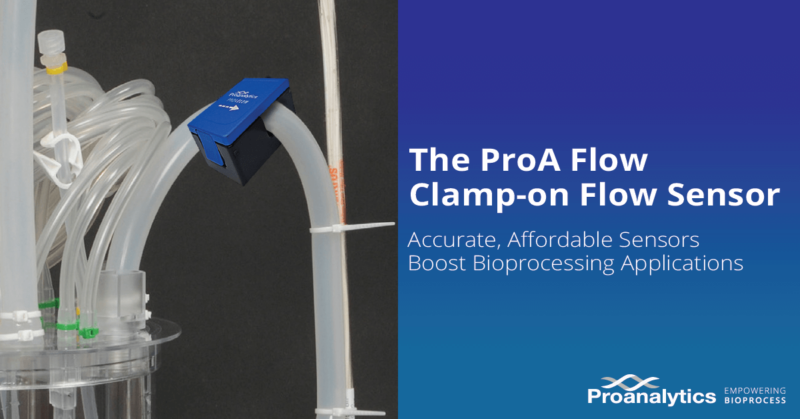Reports
The ProA Flow Clamp-on Flow Sensor: Accurate, Affordable Sensors Boost Bioprocessing Applications
Introduction
The release of the FDA’s guidance on process analytical technology (PAT) for the biopharmaceutical industry has prompted the industry to embrace adaptive processes, employing advanced control strategies to ensure consistent product quality. Adoption of PAT has become very crucial as the bioprocess industry has grown rapidly over the past two decades. The development and optimization of bioprocesses are now more analytical as several new technologies enabled accurate and detailed real-time monitoring of bioprocesses.
How Does A Flow Sensor Work?
A non-contact flow meter utilizes ultrasonic technology to measure flow rate at critical points of various biotech processes. This enables non-contact detection of flow, independent of liquid composition (turbidity, charge, temperature etc.). ProA Flow ultrasonic flow sensors clamp on to the outside of flexible tubing, send ultrasonic signals through the tubing, and directly measure flow while simultaneously calculating total volume dispensed.
Increases in Measurement Consistency & Reliability for Process Intensification
The addition of real time flow measurement allows for increased insight to critical process parameters (CPP) that are necessary for optimal batch-to-batch consistency and reliability. By non-invasively monitoring a process, setup time can be reduced by eliminating the need for in-line sensor design.
In recent years, the biotech industry has shifted priorities towards maximizing process intensification by utilizing complete single-use systems. That very single-use process requires sterility at the point of delivery. This limits the number of process analytical technology (PAT) devices that can be integrated. By adding a non-invasive flow sensor, a single-use process can still be intensified without additional validation of materials and complexity of design.
Why Consistent Flow Measurement is Important
Flow sensing is crucial in all stages of bioprocessing. Accurate and precise flow sensing and volume totalizing improve upstream processes by improving media and buffer preparation and manufacturing, media and anti-foam addition to the bioreactors, pH control in the reactors, harvesting, transfer from the harvest tank to centrifuge, mixing in batch, fed-batch and continuous and perfusion processes using bacterial fermentation, cell culture processes and processes using yeast/fungi.
Consistent flow measurement enhances the monitoring of peristaltic pump performance, enables the implementation of advanced feedback strategies for pumping, and facilitates calibration of the peristaltic pumps. In the downstream bioprocessing field, it is used on TFF & Chromatography skids for filtration, purification, and concentration; and it is used in fill and finish applications for dosing and filling. Process intensification can be achieved by the flow sensors as mentioned previously.
Clamp-On Flow Sensor Applications
Bioprocessing
- Sterile, non-invasive flow measurement
- Nutrient feed and Cell Media Dosing in Bioreactors
- Tangential Flow Filtration
- Peristaltic pump calibration & monitoring, pump feedback control loops
- Fill & Finish Applications
- Vaccine production
- High purity liquid processes, liquid chromatography
- Single-use systems, fermenters, cell culture equipment
General
- Filling equipment, spraying equipment, cooling systems, lubrication systems
- Water treatment and wastewater treatment systems
- Fluid monitoring during semiconductor manufacturing, such as high purity water and corrosive chemicals
- Food & beverage processing, such as milk, juice, beer production
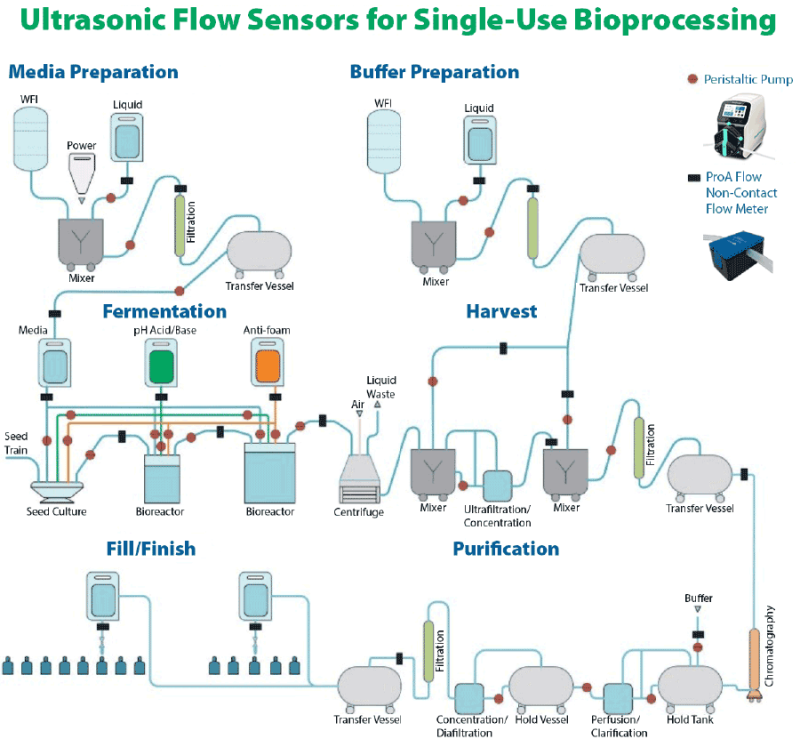
How To Select the Right Type of Flow Meter
In the bioprocessing field, the traditional way of keeping track of the volume totalization and flow rate is to measure them with a scale. However, with the integration of PAT in bioprocessing, a clamp-on flow sensor is the most common flow measurement option as they are reliable, affordable, non-invasive and easy to maintain.
In order to choose the right flow sensor, one needs to consider a couple of parameters, such as:
- The accuracy and the precision
- The output types or communication options with pumps and different software and hardware systems
- Tubing type
- Calibration schemes
- Cost
ProA Flow Sensors check all these boxes!
About the ProA Flow Clamp-on Flow Sensor
Specifications
The ProA Flow ultrasonic flow sensor has several digital and analog outputs to choose from, such as 0-20mA, 4-20mA, 0-5V, 0-10V, RS485, with Modbus and CRC protocols readily available. The included Flow Viewer software allows for the customization of these output signals, including flow switch, air detector, volume dosing, and pulse output modes. These digital outputs can be inverted, NPN, PNP, or Push-Pull. The ProA Flow sensor can also start-stop or PID control a pump, depending on the pump manufacturer.
Inline sensors are also available along with the clamp-on sensors.
Calibration
It is an industry standard to provide a factory calibration for new ultrasonic flow meters. This calibration is then further strengthened once in process by applying tubing type, fluid type, flow rate range, and process temperature to the sensor correction factors. By calibrating a clamp-on flow sensor to your specific application details, very high accuracy and repeatability can be realized.
All ProA Flow sensors come factory calibrated across their entire operational flow range. Flow Viewer software allows end users to modify this calibration as needed to provide additional accuracy. With the help of ProAnalytics’ Engineering team, a clamp-on flow sensor can be calibrated to your application details. Up to eight calibration factors can be saved and readily accessed to provide a wide range of accuracy for changing processes. These calibrations are saved directly to the sensor’s internal memory, allowing for plug and play functionality.
And lastly, the zero calibration for each process run is as simple as touching a button on the sensor or clicking a button on the software for the operator!
Tubing Compatibility
ProA Flow Sensors can work with a multitude of flexible tubing types within the temperature range of 0-60oC, including but not limited to PVC, silicone, PFA, PTFE, PE, TPE (Thermoplastic Elastomer) and flexible tubing.
Accuracy in Non-Contact Flow Meter Measurement
Lastly, let’s talk about the two parameters that vary the most between flow sensor manufacturers: Accuracy/precision and cost!
ProA Flow Sensors are rigorously tested under various conditions to mimic the real-life conditions.
How Accurate is a Clamp-On Flow Sensor?
First Test
The first test shows the accuracy in different flow rates. We have tested a CG-038 sensor with silicone tubing that has outer diameter 3/8’’ and inner diameter ¼’’. The flow rates varied between 100 mL/min to 5000 mL/min. Water is used as the liquid. A scale with precision 0.1 g is used for reference. For low flow rates, the measurements are done at least for two minutes per measurement and for high flow rates, at least 2000 g of water is collected per measurement. The error varied between -1% to 0.1% for all flow rates, with a mean error of -0.26% and standard deviation of the error 0.39%! This result is much better than the industry standard accuracy reporting.
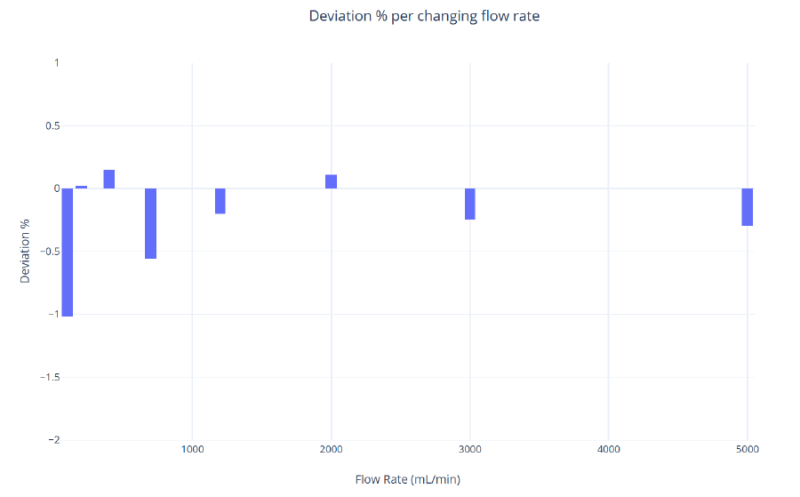
Second Test
The second test shows the repeatability of the flow rate errors on the same spot of the tubing. The same CG-038 sensor with the same tubing is used for the measurements. The flow rate is set to 400 mL/min and each measurement is done for at least two minutes. For this test, the clamp-on sensor is clamped on the same spot on the tubing. 10 measurements are done. The error varied from -0.3% to 0.2%.
Can a Non-Contact Flow Meter Achieve 1% Accuracy?
Third Test
The last test is exactly the same as the second test but this time, the sensor is clamped on different spots of the tubing. This obviously would increase the error rate as external factors such as the distance to the pump and the tubing inhomogeneity play some role. Industry standard is +/-6%, but ProA Flow sensors showed a consistent +/-1% error.
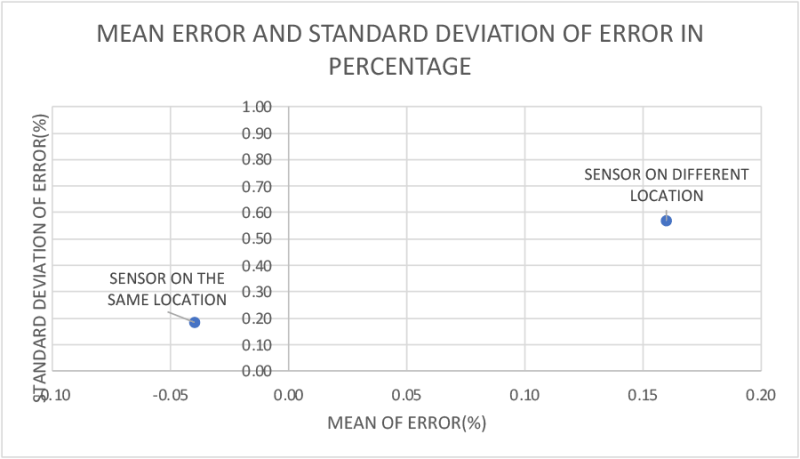
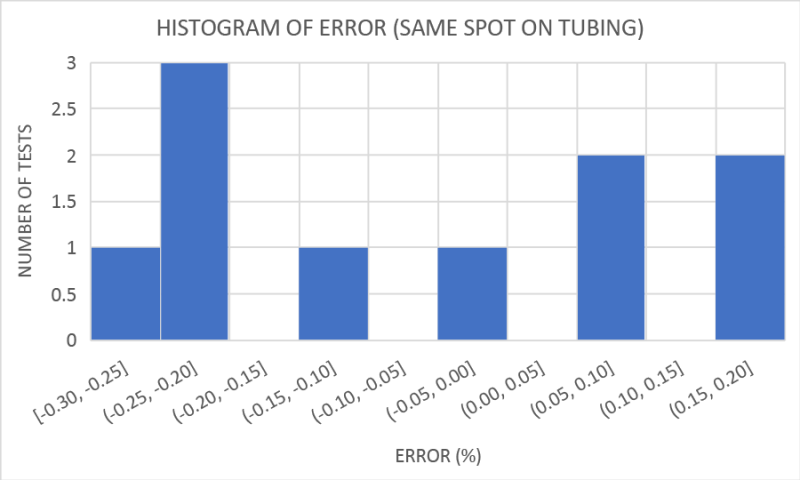
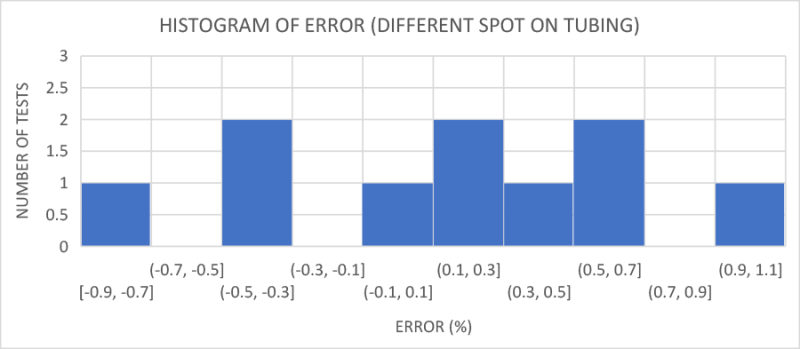
| ERROR (%) |
STD DEV (%) |
MEAN – 3*STD |
MEAN + 3*STD |
|
|---|---|---|---|---|
| DIFFERENT SPOT |
0.16 |
0.57 |
-1.54 |
1.86 |
| SAME SPOT |
-0.04 |
0.18 |
-0.59 |
0.51 |
In addition to these benefits, ProA Flow sensors bring a cost-effective solution to the industry, complemented by excellent post-sales service! This allows you to integrate online flow sensing PAT in every aspect of your process with minimal budget and effort required. Check out the ProA Flow Ultrasonic Flow Sensor and contact ProAnalytics for more information and to request a demo!
Resources
- Learn more about ProA Flow Communication Options
- Read our Non-Contact Flow Meter FAQ
- Request a Custom Flow Sensor Quote

